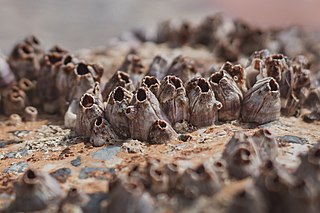
Balanus is a genus of barnacles in the family Balanidae of the subphylum Crustacea.

Ostrea is a genus of edible oysters, marine bivalve mollusks in the family Ostreidae, the oysters.
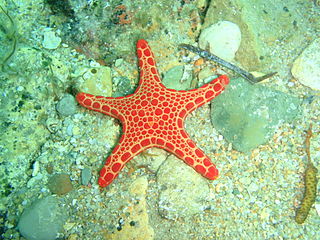
Goniasteridae constitute the largest family of sea stars, included in the order Valvatida. They are mostly deep-dwelling species, but the family also include several colorful shallow tropical species.

Conulus is an extinct genus of echinoids that lived in the Cretaceous. Remains of Conulus species have been found in Asia, Europe, and North America.
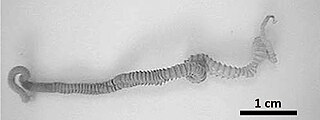
Gigantorhynchus is a genus of Acanthocephala that parasitize marsupials, anteaters, and possibly baboons by attaching themselves to the intestines using their hook-covered proboscis. Their life cycle includes an egg stage found in host feces, a cystacanth (larval) stage in an intermediate host such as termites, and an adult stage where cystacanths mature in the intestines of the host. This genus is characterized by a cylindrical proboscis with a crown of robust hooks at the apex followed by numerous small hooks on the rest of the proboscis, a long body with pseudosegmentation, filiform lemnisci, and ellipsoid testes. The largest known specimen is the female G. ortizi with a length of around 240 millimetres (9.4 in) and a width of 2 millimetres (0.08 in). Genetic analysis on one species of Gigantorhynchus places it with the related genus Mediorhynchus in the family Gigantorhynchidae. Six species in this genus are distributed across Central and South America and possibly Zimbabwe. Infestation by a Gigantorhynchus species may cause partial obstructions of the intestines, severe lesions of the intestinal wall, and may lead to death.

Cidaridae is a family of sea urchins in the order Cidaroida.
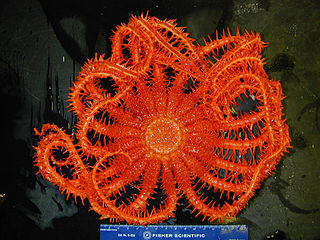
The Brisingidae are a family of starfish found only in the deep sea. They inhabit both the Atlantic and Pacific Oceans at abyssal depths, and also occur in the Southern Ocean and around Antarctica at slightly shallower depths.

Schizaster is a genus of heart urchins belonging to the family Schizasteridae. The type species of the genus is Schizaster studeri.

Parechinus angulosus, the Cape urchin, is a sea urchin in the family Parechinidae endemic to southern Africa. It is the only species in the genus Parechinus.

Brissus is a genus of echinoderms belonging to the family Brissidae.

Astriclypeidae is a family of echinoderms belonging to the order Clypeasteroida.
Echinocyamus is a genus of echinoderms belonging to the family Fibulariidae.

Stereocidaris is a genus of echinoderm belonging to the family Cidaridae.

Metalia is a genus of echinoderms belonging to the family Brissidae.
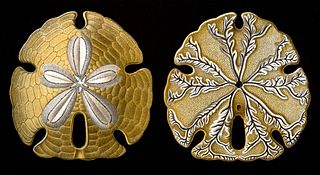
Encope emarginata, a notched sand dollar, is a marine echinoid ranging the western Atlantic ocean. They are best known for their bioturbation in the sediment, relationship with crabs, and their widespread distribution.
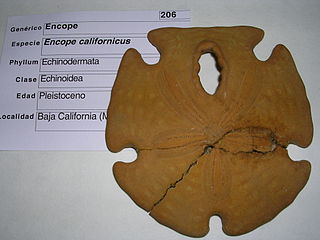
Encope is a genus of echinoderms belonging to the family Mellitidae.
Echinodiscus is the scientific name of several genera of organisms and may refer to:

Echinodiscus bisperforatus is a species of sand dollar described by Nathanael Gottfried Leske in 1778. The species is found throughout the Indo-Pacific in the Red Sea and off the coasts of south and east South Africa, Thailand, Malayan Archipelago, and New Caledonia at depths up to 20 meters. It grows to lengths of 11.8 centimeters.

Sculpsitechinus is a genus of sand dollars within the family Astriclypeidae. There are currently 3 species assigned to the genus, with members being found near Africa, Asia, and Australia in the Pacific and Indian Ocean.


















